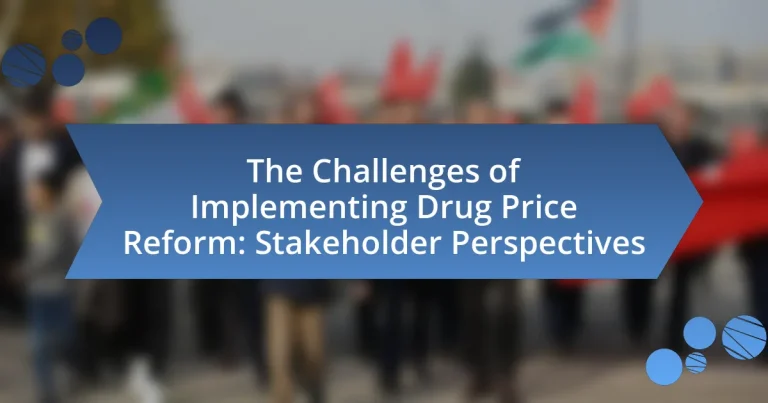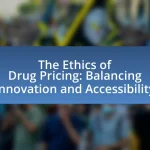The article focuses on the challenges of implementing drug price reform, highlighting the perspectives of various stakeholders, including pharmaceutical companies, healthcare providers, and patient advocacy groups. Key challenges include resistance from pharmaceutical companies due to concerns over profit margins, regulatory complexities that complicate the establishment of clear pricing frameworks, and fears that price reductions may hinder innovation. The article also examines how government policies and political barriers impact reform efforts, as well as the economic implications of drug pricing on healthcare costs and patient access to medications. Strategies for overcoming these challenges through collaboration and transparency among stakeholders are also discussed, emphasizing the importance of aligning interests to achieve effective reform.
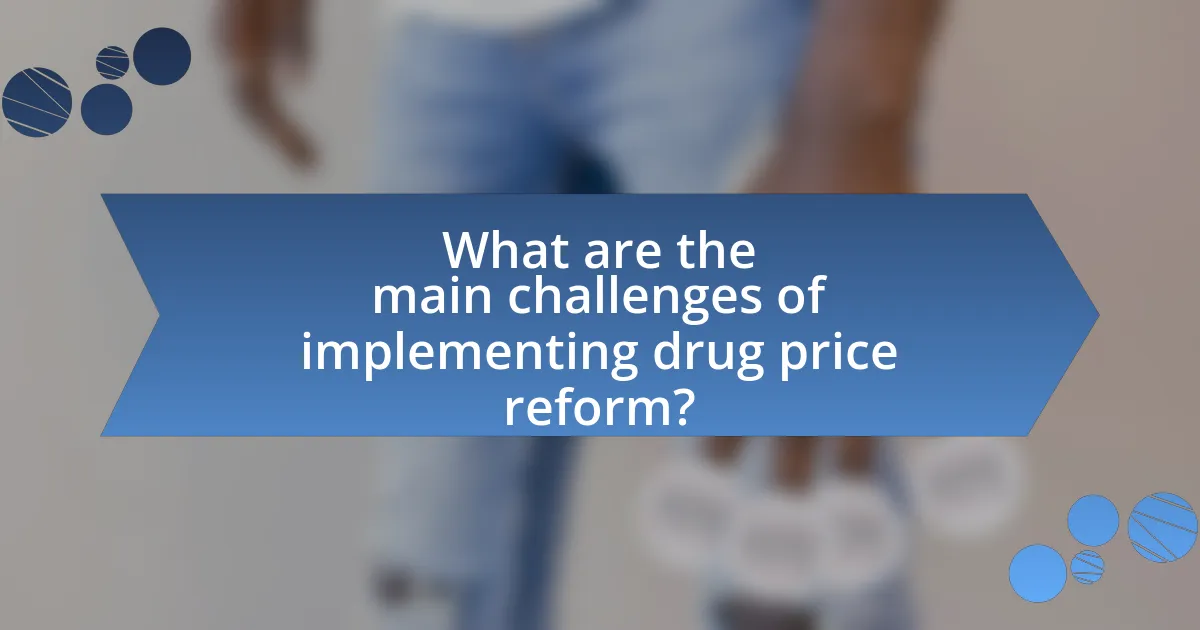
What are the main challenges of implementing drug price reform?
The main challenges of implementing drug price reform include resistance from pharmaceutical companies, regulatory complexities, and potential impacts on innovation. Pharmaceutical companies often oppose reforms due to concerns over profit margins, which can lead to lobbying efforts that stall legislative changes. Regulatory complexities arise from the need to navigate existing laws and policies that govern drug pricing, making it difficult to establish a clear framework for reform. Additionally, there is a fear that lowering prices could deter investment in research and development, ultimately hindering innovation in the pharmaceutical industry. These challenges are supported by various studies indicating that price controls can lead to reduced availability of new drugs and therapies, as evidenced by research from the National Bureau of Economic Research, which highlights the correlation between price regulation and decreased pharmaceutical innovation.
How do different stakeholders perceive these challenges?
Different stakeholders perceive the challenges of implementing drug price reform through varied lenses based on their interests and roles. Pharmaceutical companies often view these challenges as threats to their profit margins and innovation incentives, arguing that price controls could stifle research and development. In contrast, healthcare providers and patient advocacy groups perceive these challenges as opportunities to enhance access to essential medications, emphasizing the need for affordability and equitable healthcare. Policymakers face the challenge of balancing these competing interests while ensuring that reforms lead to sustainable healthcare systems. Evidence from studies, such as the 2021 report by the National Academy of Sciences, indicates that stakeholder perceptions significantly influence the feasibility and design of drug pricing policies, highlighting the complexity of achieving consensus in reform efforts.
What are the concerns of pharmaceutical companies regarding drug price reform?
Pharmaceutical companies are primarily concerned that drug price reform will significantly reduce their revenues and profit margins. This concern arises from the potential for government-imposed price controls, which could limit the prices they can charge for medications. For instance, a study by the American Enterprise Institute indicated that such reforms could lead to a decrease in research and development funding, ultimately stifling innovation in drug development. Additionally, pharmaceutical companies fear that price reforms may lead to increased competition from generic drugs, further eroding their market share and financial stability.
How do healthcare providers view the implications of drug price reform?
Healthcare providers generally view the implications of drug price reform as a mixed bag, recognizing potential benefits alongside significant challenges. They acknowledge that reform could lead to reduced medication costs for patients, improving access to essential treatments. However, providers also express concerns about the potential impact on pharmaceutical innovation and the availability of new therapies, as lower prices may reduce the revenue that companies rely on to fund research and development. A survey conducted by the American Medical Association found that 70% of physicians believe that while drug price reform is necessary, it must be balanced to ensure that it does not stifle innovation in the pharmaceutical industry.
What are the perspectives of patients and consumer advocacy groups on drug price reform?
Patients and consumer advocacy groups generally support drug price reform, emphasizing the need for affordable access to medications. They argue that high drug prices create barriers to treatment, leading to negative health outcomes and increased financial strain on families. Advocacy groups often cite statistics indicating that nearly one in four Americans have reported not filling a prescription due to cost, highlighting the urgency for reform. Furthermore, these groups advocate for transparency in pricing and the negotiation of drug prices by government entities to ensure that medications are accessible to all, particularly vulnerable populations.
What role does government policy play in drug price reform challenges?
Government policy significantly influences drug price reform challenges by establishing regulatory frameworks that dictate pricing structures and market access. Policies such as price controls, patent regulations, and reimbursement strategies directly affect how pharmaceutical companies set prices and how consumers access medications. For instance, countries with stringent price regulation often face pushback from pharmaceutical companies, which argue that such policies stifle innovation and limit the availability of new drugs. Additionally, government negotiations with drug manufacturers can lead to lower prices but may also result in limited drug availability or delayed market entry for new treatments. These dynamics illustrate the complex interplay between government policy and the pharmaceutical market, highlighting the challenges stakeholders face in achieving effective drug price reform.
How do regulatory frameworks impact the implementation of drug price reform?
Regulatory frameworks significantly influence the implementation of drug price reform by establishing the legal and operational guidelines that govern pricing strategies. These frameworks dictate how prices can be set, negotiated, and adjusted, impacting the ability of stakeholders, such as pharmaceutical companies and healthcare providers, to adapt to new pricing models. For instance, countries with stringent regulations may limit the extent to which drug prices can be lowered, thereby hindering reform efforts. Additionally, regulatory bodies often require extensive evidence of cost-effectiveness and clinical benefit before approving price changes, which can delay or complicate the reform process. Historical examples, such as the implementation of price controls in countries like Canada, demonstrate that regulatory frameworks can either facilitate or obstruct the adoption of innovative pricing strategies, depending on their design and enforcement.
What are the political barriers to effective drug price reform?
Political barriers to effective drug price reform include lobbying by pharmaceutical companies, partisan divisions in government, and the influence of interest groups. Pharmaceutical companies often invest heavily in lobbying efforts to protect their profit margins, which can lead to resistance against price regulation. Additionally, partisan divisions can result in conflicting priorities, making it difficult to achieve consensus on reform measures. Interest groups, including patient advocacy organizations and healthcare providers, may also have differing views on the implications of drug pricing changes, complicating the legislative process. These factors collectively hinder the implementation of comprehensive drug price reforms.
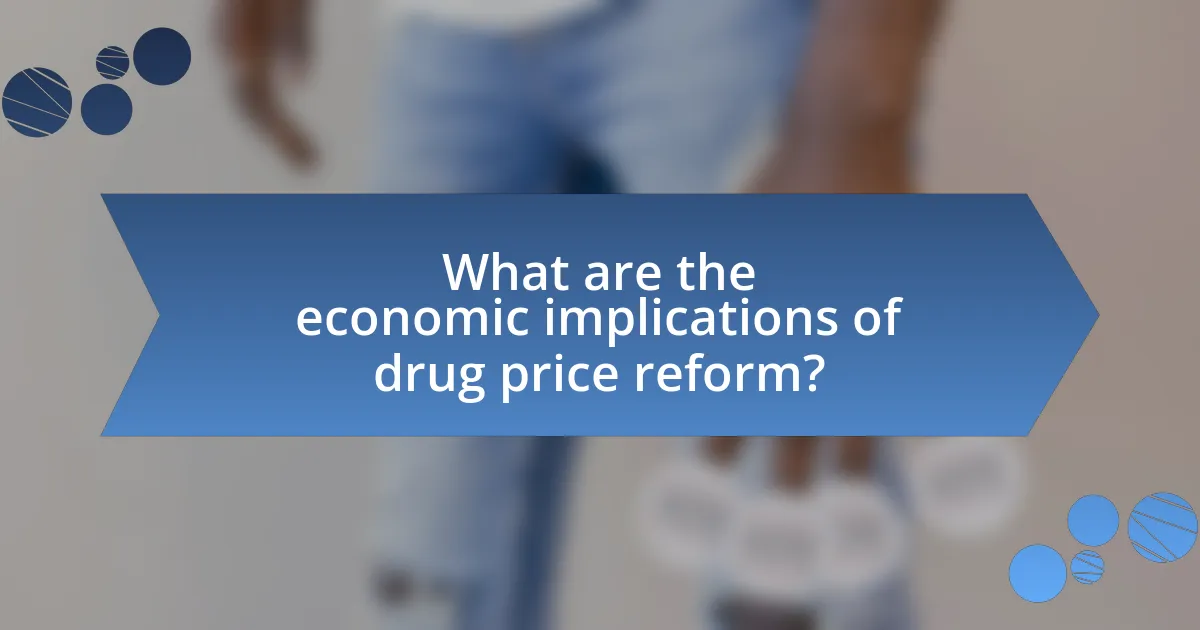
What are the economic implications of drug price reform?
Drug price reform can lead to significant economic implications, including reduced healthcare costs and increased access to medications. By lowering drug prices, consumers may experience decreased out-of-pocket expenses, which can enhance overall public health and productivity. A study by the House of Representatives Ways and Means Committee in 2020 indicated that high drug prices contribute to approximately $1.3 trillion in annual healthcare spending in the United States. Additionally, reform can stimulate competition among pharmaceutical companies, potentially leading to innovation and improved drug development. However, it may also result in reduced revenue for drug manufacturers, which could impact their ability to invest in research and development.
How does drug pricing affect healthcare costs overall?
Drug pricing significantly impacts overall healthcare costs by directly influencing the expenses incurred by patients, insurers, and healthcare providers. High drug prices lead to increased out-of-pocket costs for patients, which can result in delayed treatments or non-adherence to prescribed therapies. According to a study published in Health Affairs, nearly one in four Americans reported not filling a prescription due to cost, highlighting the financial burden that high drug prices impose on individuals. Additionally, insurers often pass on the costs of expensive medications to consumers through higher premiums and deductibles, further escalating overall healthcare expenditures. This cycle of high drug prices contributing to increased healthcare costs underscores the urgent need for reform in drug pricing policies to alleviate financial strain on the healthcare system.
What is the relationship between drug prices and insurance premiums?
Drug prices directly influence insurance premiums, as higher drug costs lead to increased expenses for insurers, which are then passed on to consumers through higher premiums. For instance, a study by the Kaiser Family Foundation found that rising prescription drug prices accounted for a significant portion of the overall increase in health insurance premiums over the past decade. This relationship underscores how fluctuations in drug pricing can impact the affordability of health insurance for consumers.
How do drug prices influence patient access to medications?
Drug prices significantly influence patient access to medications by determining affordability and availability. High drug prices can lead to patients forgoing necessary treatments due to financial constraints, as evidenced by a 2021 survey from the Kaiser Family Foundation, which found that nearly one in four Americans reported not filling a prescription due to cost. Additionally, when medications are priced beyond what patients can afford, it can result in increased health disparities, as lower-income individuals are disproportionately affected. This relationship between drug pricing and access highlights the critical need for reform in pharmaceutical pricing to ensure equitable access to essential medications for all patients.
What are the potential benefits of successful drug price reform?
Successful drug price reform can lead to increased access to medications for patients. By lowering prices, more individuals can afford necessary treatments, which can improve overall public health outcomes. For instance, a study by the National Academy of Sciences found that reducing drug prices could prevent thousands of deaths annually by making life-saving medications accessible to a broader population. Additionally, successful reform can alleviate financial burdens on healthcare systems, allowing for reallocation of resources to other critical areas of care. This can enhance the sustainability of healthcare systems, as evidenced by countries with regulated drug prices that report lower overall healthcare spending while maintaining high health outcomes.
How could drug price reform improve public health outcomes?
Drug price reform could improve public health outcomes by increasing access to essential medications for a larger segment of the population. When drug prices are lowered, more individuals can afford necessary treatments, leading to better adherence to prescribed therapies and ultimately reducing the incidence of preventable diseases. For instance, a study published in Health Affairs found that reducing the cost of diabetes medications significantly increased adherence rates, resulting in fewer hospitalizations and improved overall health metrics among patients. This demonstrates that lowering drug prices directly correlates with enhanced public health outcomes through improved medication access and adherence.
What economic advantages could arise from lower drug prices?
Lower drug prices can lead to significant economic advantages, including increased access to medications, reduced healthcare costs, and improved public health outcomes. When drug prices decrease, more individuals can afford necessary treatments, which can lead to a healthier population and decreased long-term healthcare expenditures. For instance, a study published in Health Affairs found that lowering drug prices could save the U.S. healthcare system approximately $100 billion annually by reducing hospitalizations and other costly medical interventions associated with untreated conditions. Additionally, lower drug prices can stimulate economic growth by allowing consumers to allocate their savings toward other goods and services, thereby boosting overall economic activity.
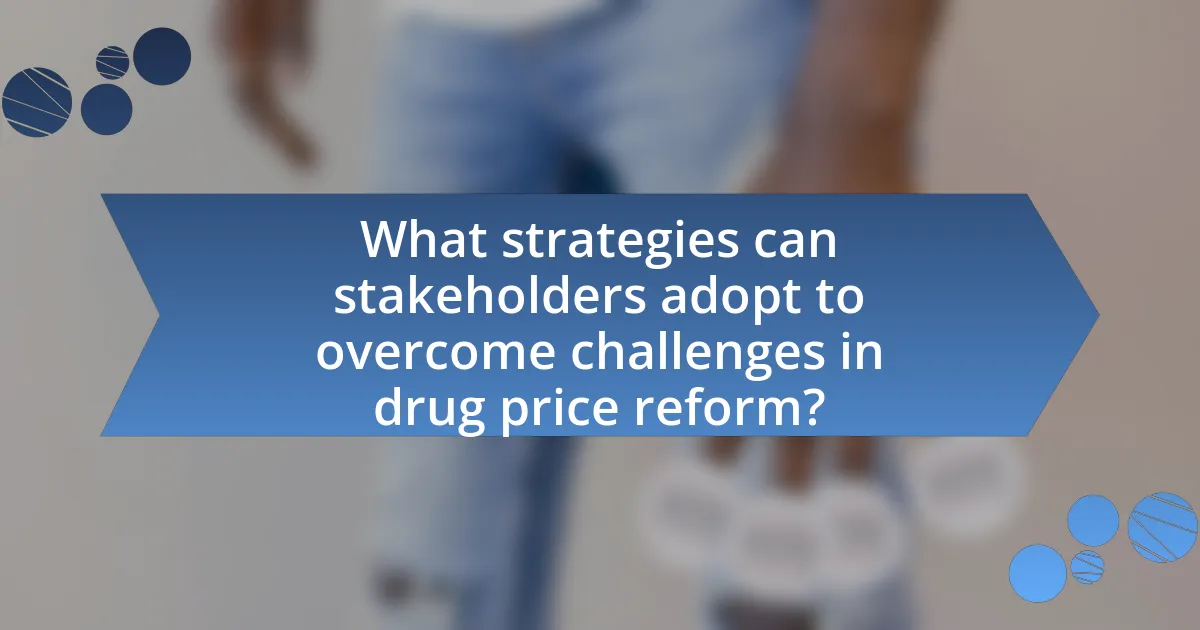
What strategies can stakeholders adopt to overcome challenges in drug price reform?
Stakeholders can adopt collaborative negotiation strategies to overcome challenges in drug price reform. By engaging in dialogue among pharmaceutical companies, healthcare providers, insurers, and government entities, stakeholders can identify common goals and create mutually beneficial agreements. For instance, the implementation of value-based pricing models, where drug prices are tied to the clinical outcomes they deliver, has been shown to align incentives and improve access to medications. Additionally, leveraging data analytics to assess drug effectiveness and cost-effectiveness can provide a solid foundation for negotiations, as evidenced by successful reforms in countries like the United Kingdom, where the National Institute for Health and Care Excellence evaluates new drugs based on their value to the healthcare system.
How can collaboration among stakeholders facilitate drug price reform?
Collaboration among stakeholders can facilitate drug price reform by aligning interests and resources to create comprehensive strategies that address pricing issues. When pharmaceutical companies, healthcare providers, insurers, and government entities work together, they can share data, insights, and best practices that lead to more transparent pricing models. For instance, the National Academy of Medicine has highlighted that multi-stakeholder collaborations can lead to innovative payment models that tie drug prices to patient outcomes, thereby ensuring that costs reflect the value provided. This collective approach can also enhance negotiation power, allowing stakeholders to advocate for fairer prices and reduce the overall financial burden on patients and the healthcare system.
What role do coalitions and partnerships play in addressing reform challenges?
Coalitions and partnerships play a crucial role in addressing reform challenges by fostering collaboration among diverse stakeholders, which enhances the effectiveness of drug price reform initiatives. These alliances bring together government entities, healthcare providers, patient advocacy groups, and pharmaceutical companies, allowing for a comprehensive approach to reform that considers multiple perspectives and interests. For instance, the collaboration between the American Medical Association and patient advocacy groups has led to more robust proposals for drug pricing transparency, demonstrating how partnerships can amplify voices and drive policy changes. Additionally, coalitions can pool resources and expertise, enabling more effective advocacy and implementation strategies, as seen in the efforts of the Campaign for Sustainable Rx Pricing, which unites various stakeholders to push for legislative reforms.
How can stakeholders effectively communicate the need for reform?
Stakeholders can effectively communicate the need for reform by utilizing data-driven arguments and engaging in transparent dialogue with the public and policymakers. For instance, presenting statistics on rising drug prices and their impact on healthcare access can illustrate the urgency for reform. A study by the Kaiser Family Foundation found that nearly one in four Americans reported not filling a prescription due to cost, highlighting the real-world consequences of inaction. Additionally, stakeholders should leverage social media platforms to amplify their message and foster community support, as demonstrated by successful campaigns that mobilized public opinion around healthcare issues.
What best practices can be implemented for effective drug price reform?
Effective drug price reform can be achieved through several best practices, including implementing transparent pricing models, negotiating prices with pharmaceutical companies, and utilizing value-based pricing strategies. Transparent pricing models allow consumers and stakeholders to understand the costs associated with drug development and distribution, fostering accountability. Negotiating prices with pharmaceutical companies can lead to reduced costs for consumers, as seen in countries with national health systems that leverage collective bargaining power. Value-based pricing strategies ensure that drug prices reflect the therapeutic benefits provided, aligning costs with patient outcomes, which has been successfully implemented in various healthcare systems, such as the UK’s National Health Service. These practices collectively contribute to a more equitable and sustainable drug pricing framework.
What lessons can be learned from successful drug price reform initiatives in other countries?
Successful drug price reform initiatives in other countries demonstrate the importance of government negotiation power, transparency in pricing, and the establishment of value-based pricing models. For instance, countries like Canada and Australia have effectively negotiated drug prices through centralized purchasing systems, which have led to lower costs for consumers. Additionally, transparency in pricing has been shown to foster competition among pharmaceutical companies, as seen in Germany’s approach, where drug prices are negotiated based on therapeutic benefit. Furthermore, value-based pricing models, utilized in countries like the United Kingdom, link drug prices to the health outcomes they deliver, ensuring that expenditures align with patient benefits. These lessons highlight the need for strategic policy frameworks that prioritize affordability and accessibility in healthcare.
How can data and transparency improve the drug pricing process?
Data and transparency can significantly improve the drug pricing process by enabling informed decision-making and fostering competition among pharmaceutical companies. When comprehensive pricing data is made available, stakeholders, including healthcare providers and patients, can better understand the cost structures and value of medications. This transparency can lead to increased accountability, as companies are compelled to justify their pricing strategies based on market data and patient outcomes. For instance, a study published in the Journal of Health Economics found that increased transparency in drug pricing led to a 10% reduction in prices for certain medications, demonstrating the direct impact of data availability on pricing strategies. By leveraging data analytics, stakeholders can identify price discrepancies and advocate for fairer pricing, ultimately benefiting consumers and the healthcare system as a whole.
What are the key takeaways for stakeholders involved in drug price reform?
Key takeaways for stakeholders involved in drug price reform include the necessity for collaboration among pharmaceutical companies, government entities, and healthcare providers to create sustainable pricing models. Stakeholders must recognize that transparency in pricing can enhance trust and facilitate informed decision-making. Additionally, understanding the impact of drug pricing on patient access and health outcomes is crucial; studies indicate that high drug prices can lead to medication non-adherence, ultimately affecting public health. Engaging in evidence-based policy discussions can help stakeholders navigate the complexities of reform while balancing innovation incentives with affordability.
